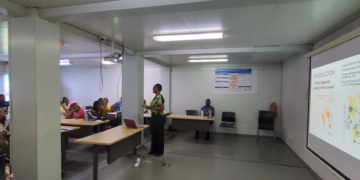A huge gap in laboratory and scientific capacity is hindering Africa’s ability to test for Anti-Microbial Resistance (AMR), thereby exposing the region’s population to a high rate of anti-microbial drug resistance cases, a new study has revealed.
The study, conducted by the Africa Centers for Disease Control and Prevention (Africa CDC) in collaboration with the African Society for Laboratory Medicine (ASLM), focused on 14 Member States of the African Union, including Sierra Leone.
Its findings are detailed in a report titled: ‘The Crisis Within The Crisis,’ which was published on Monday, July 24. It reveals that only five out of the 15 antibiotic pathogens combinations prioritized by the World Health Organization (WHO) are being consistently tested on the continent.
The researchers also found that most laboratories across the continent are not ready for AMR testing, with just over 1% of the 50,000 medical laboratories forming the tiered laboratory networks of the 14 participating countries found to be conducting bacteriology testing and even fewer capable of conducting the scientific process of determining AMR.
“This underlies the importance of further investment in laboratory capacity, including microbial systems, equipment and training,” said the Africa CDC in a statement.
The study is the first phase of the Mapping Antimicrobial Resistance and Antimicrobial Use Partnership (MAAP), a consortium that focuses on the responses to the global threat of anti-microbial resistance. This consortium is co-led by the Africa CDC and ASLM, with the support of the UK Aid Fleming Fund.
The findings were presented in 14 separate reports, each focusing on the individual member states featured in the study. They provide a detailed study representation of the AMR situation in each of the countries.
Other West African countries featured are Burkina Faso, Ghana, Nigeria and Senegal. Also part of the study from elsewhere on the continent are Cameroon, Eswatini, Gabon, Kenya, Malawi, Tanzania, Uganda, Zambia and Zimbabwe.
The findings contain over 819,500 AMR data records, covering the period from 2016 to 2019, according to the report. It also involved AMR surveillance data analysed from 205 laboratories across the 14 countries.
The authors hope that the findings will shape health policy reform in the region.
The study provides a unique source of information to feed into the national AMR action plan, national laboratory strategic plan, and other relevant policies in Africa, says the Africa CDC.
The Africa CDC is an autonomous health agency of the AU, tasked with strengthening the capacity and capability of the region’s public health institutions to detect, prevent, control and respond quickly and effectively to disease threat. The MAAP is a multi-organization and multi-national consortium led by ASLM, with funding from the UK Government, with the goal of improving laboratory capacity and diagnosis as well as data and surveillance of the AMR through the ‘One Health’ approach. The initiative basically seeks to establish a system for the collection, storage and analysis of AMR and antimicrobial use data across the continent.
“MAAP has collaborated with African Union Member States and put AMR on the map of Africa for the first time. A critical step to address the threat of AMR on the continent,” said Dr Yewande Alimi, Africa CDC AMR Programme Coordinator.
“The lack of bacteriology and AMR testing capacity documented by MAAP has been an eye-opener,” added Pascale Ondoa, Director of Science and New Initiatives at ASLM, noting that these reports constitute a “unique resource” for national, regional and global stakeholders working at reducing the burden of AMR.
According to the report, the MAAP researchers also documented an “alarming” picture of antimicrobial consumption (AMC) with a combined lack of access and erratic use of antimicrobials. Among other key findings is that only four drugs comprised more than two-thirds (67%) of all the antibiotics used in the healthcare setting, while reserve-category antibiotics were found in only six of the 14 MAAP Member States. Unregulated antibiotic fixed combinations represented 3.4% of all consumed antibiotics.
“AMR stands as one of the leading public health challenges of the 21st century, with Africa having the world’s highest mortality rate from AMR infections, resulting in over 27 deaths per 100,000,” according to the Africa CDC. It said that without data information on the rates, drivers, and trends of AMR on both antimicrobial use and antimicrobial consumption, health experts will be ‘flying blind’ and cannot develop and deploy policies to limit or curtail AMR.
Interventions in Africa mostly remain generic since no baseline information on the magnitude of the problem is available at national or regional levels, the agency said.
In the face of the threat of the rise of drug-resistant organisms, AU Heads of State and Government in 2020 committed to urgently addressing the threat of AMR across multiple sectors, especially human health, animal health, and agriculture.
The Africa Union Framework for Antimicrobial Resistance Control, 2020-2025 details strategies for Africa CDC to improve data surveillance, delay AMR emergence, limit transmission and mitigate harm from resistant pathogens.






















